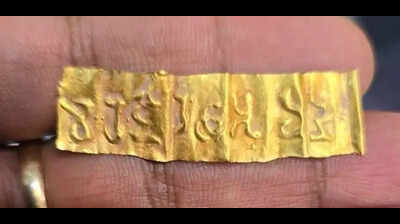- News
- City News
- Hyderabad News
- Ancient Prakrit inscription on gold sheet found in Pakistan’s Swat Valley
Trending
Ancient Prakrit inscription on gold sheet found in Pakistan’s Swat Valley
Hyderabad: The Archaeological Survey of India (ASI) has identified a gold sheet inscribed with a Prakrit inscription in Brahmi script, dating to the 3rd century CE. The artifact, originating from Pakistan's Swat Valley in Khyber Pakhtunkhwa province, is currently in a private collection in Hong Kong.
According to K Muniratnam Reddy, ASI's director of epigraphy, the inscription reads "Marjara(ja) a (da)n," likely referring to a royal donation. ASI believes it likely documents a donation, possibly linked to the Buddha. The sheet was sourced for study by Professor YS Alone of Jawaharlal Nehru University, Delhi.
Engraved in Brahmi script, the text provides insights into Buddhist patronage and the spread of Prakrit inscription in northwestern South Asia during the early centuries. ASI has not disclosed details on the sheet's dimensions or discovery context but suggests it was part of Buddhist royal endowments.
This discovery follows recent ASI findings in Pakistan and Pakistan-Occupied Kashmir. In Dec 2024, ASI deciphered a 4th century Brahmi inscription near Gilgit, recording the installation of a Mahesvaralinga by Pushpasingha in his guru's honour. The inscription was brought to ASI's attention by Shiv Pratap Singh from Rajasthan.
Five months earlier, ASI studied a 10th century Sanskrit inscription in Sharada script near Peshawar, referencing Buddhist ‘dharinis' (chants). A damaged portion of the inscription included the word dharini.

About the Author
U Sudhakar ReddyEnd of Article
FOLLOW US ON SOCIAL MEDIA









